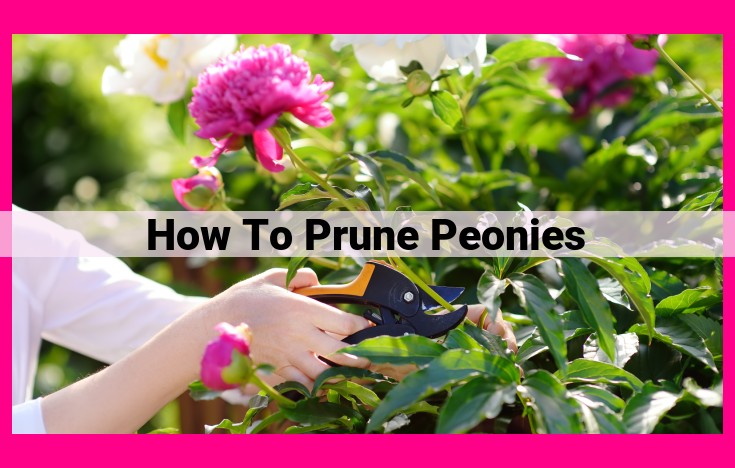Comprehensive Guide To Pruning Peonies For Optimal Health And Beauty

To prune peonies effectively, follow these steps: Remove all stems to the ground in fall to encourage growth and prevent disease, or cut them back in late winter to remove dead parts and stimulate new shoots. In late autumn, trim stems lightly to remove any remaining foliage. Additionally, deadhead spent flowers to promote new buds. Use sharp shears for precise cuts and loppers for thicker stems. Consider factors such as plant maturity, size, light and soil conditions, and pest or disease concerns when pruning.
The Art of Pruning: Techniques and Tips for Lush and Healthy Plants
Pruning is a crucial gardening practice that helps maintain the health, shape, and productivity of your plants. Whether you’re an avid gardener or a novice just starting out, understanding the techniques and factors involved will empower you to transform your garden into a thriving oasis.
Pruning Techniques: A Seasonal Symphony
Ground-level Pruning (Fall):
As the leaves fall and the cold sets in, embrace ground-level pruning. This technique involves removing all stems to the ground, creating a blank canvas for new growth. This drastic cut promotes vigorous growth and helps prevent the spread of diseases that may linger in fallen foliage.
Late-Winter Pruning (Early Spring):
When spring’s gentle breeze awakens the garden, it’s time for late-winter pruning. This technique focuses on cutting back stems to remove any dead or damaged parts. By eliminating these weak points, you encourage new shoots to emerge, bringing fresh life to your plants.
Fall Pruning (Late Autumn):
As the days grow shorter and the air turns crisp, engage in fall pruning. This light trim involves removing any remaining foliage or seed heads. By doing so, you reduce the risk of fungal diseases over the winter months and prepare your plants for the coming spring season.
Deadheading:
Throughout the growing season, diligently remove spent flowers, a practice known as deadheading. This simple technique prevents the plant from putting energy into seed production and redirects it towards producing new buds. As a result, you’ll enjoy a continuous display of blooms that adds color and vibrancy to your garden.
Essential Tools for Effective Pruning
In the realm of gardening, pruning emerges as a crucial practice that rejuvenates plants, enhances their health, and fosters their beauty. Embark on this essential gardening task armed with the right tools, such as sharp shears and loppers.
Sharp Shears: Precision in Pruning
Consider sharp shears as the scalpel of pruning, meticulously crafted to execute precise, clean cuts. Their sharp blades effortlessly slice through stems, leaving a clean wound that reduces the risk of infection and promotes healing. The precision offered by shears ensures targeted trimming, enabling you to remove specific branches or shape delicate plants with utmost accuracy.
Loppers: Tackling Tougher Twigs
For stems that exceed the capacity of shears, turn to the strength of loppers. These robust tools boast elongated handles that provide leverage, empowering you to sever thicker branches with ease. Loppers are particularly invaluable when managing overgrown shrubs, removing dead or diseased limbs, and shaping mature trees. Their sharp blades ensure clean cuts, minimizing damage to the plant and facilitating its recovery.
Selecting the Right Tool for the Job
The choice between shears and loppers hinges on the size and thickness of the stems you intend to prune. For delicate stems, shears reign supreme, while loppers become indispensable for larger, tougher branches. Remember, the proper tools can make all the difference in the precision and efficiency of your pruning endeavors.
Factors Influencing Pruning: A Guide to Nurturing Healthy Plants
Pruning is an essential gardening practice that helps maintain plant health, shape, and productivity. However, the techniques and considerations involved in pruning vary significantly depending on the unique characteristics of each plant. Let’s delve into the key factors that influence pruning decisions.
Plant Maturity
The age and size of a plant play a crucial role in determining the appropriate pruning technique. Young plants, particularly in their first few years, may require minimal pruning to establish a strong framework. As they mature, however, more extensive pruning may be necessary to remove dead or unproductive wood, stimulate new growth, and control plant size.
Plant Size
The overall size of a plant also influences its pruning needs. Larger plants, such as trees and shrubs, typically require more extensive pruning to maintain their shape, remove diseased or damaged branches, and promote fruit or flower production. Smaller plants, on the other hand, may need less frequent or less drastic pruning to maintain their health and appearance.
Light and Soil Conditions
The amount of sunlight and quality of soil can also affect pruning decisions. Plants that receive ample sunlight may tolerate more severe pruning than those in shaded areas. Similarly, plants grown in rich, well-drained soil may require less pruning than those in poor or compacted soil, as they are more likely to produce healthy, vigorous growth.
Pest and Disease Control
Pruning can be an effective tool in pest and disease control. By removing infected or damaged parts of a plant, you can prevent the spread of diseases and reduce the risk of pests. For example, removing diseased leaves or branches can help control fungal infections, while pruning away infested stems can help eliminate insects.
By considering these factors, you can tailor your pruning practices to the specific needs of your plants, ensuring their continued health, productivity, and beauty.